Vermont is known for its green rolling hills, maple syrup, and beautiful scenery. However, it also has an abundance of another natural resource – mushrooms!
From the dense forests of the Northeast Kingdom to the rolling hills of the Champlain Valley, Vermont offers an abundance of wild mushrooms for foragers to discover and enjoy.
Whether you are an amateur mushroom hunter or a professional chef, there’s sure to be something fun and delicious just waiting for you to discover it.
Common Vermont mushrooms include inky caps, chicken of the woods, aborted entomolas, puffballs, and of course morels. Below, we’ll discuss these common mushrooms and more; how to identify and uses.
List of Vermont Mushrooms
1. Chanterelle

From Middlebury to Washington Co. chanterelles are one of the most popular mushrooms for foragers and mushroom hunters. Chanterelles in Vermont come in three varieties.
Black chanterelles: These mushrooms have a black-grayish funnel-shaped cap that varies in size and typically measures between 2 to 3 inches in diameter. Fruiting bodies grow close to each other and grow to 6 inches.
White chanterelle: These types of chanterelles are chunkier than their black and golden relatives. The white-creamy funnel cap grows to 6 inches.
Golden chanterelle: These chanterelles are the most common and easily identifiable member of their family. They grow in groups and are bright orange-yellow in color with false gills. These chanterelles also have an apricoty smell.
When can you find chanterelles in Vermont? They start popping out in early summer and peak mid summer. Some foragers have been able to collect more than 10lbs in 2 hours!
2. Lactarius Indigo (Indigo Milk Cap)
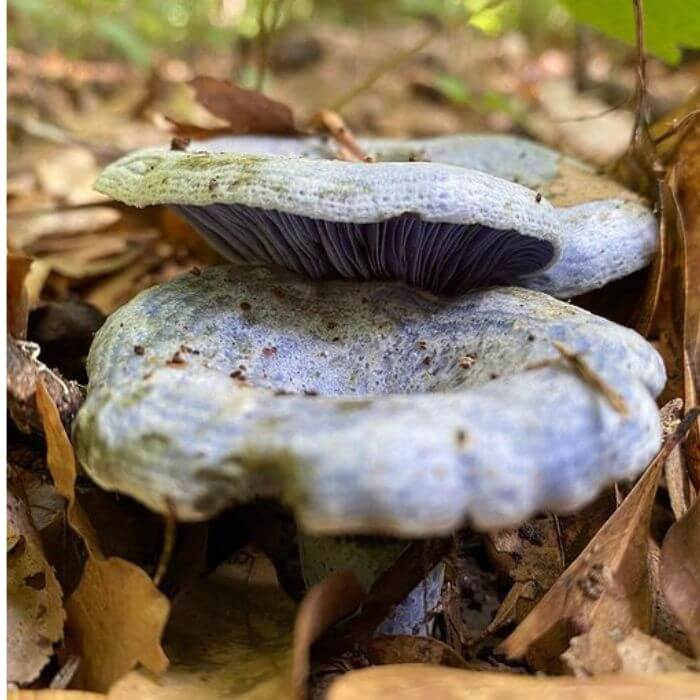
source:marcomtz1987
We recently discussed blue mushrooms and the lactarius indigo was on the list. This milky cap is found in some parts of Vermont. Has been observed in Emerald Lake State Park.
Identification:
This mushroom belongs to the genus Lactarius, which includes over 300 species of mushrooms that produce a milky substance when cut or broken.
The Lactarius indigo has an unmistakeable blue-green hue on its cap and dark blue gills that are attached to the stem.
There is a slight depression on aged mushrooms and the margins remain inwards curved. It also has a radially symmetric shape and can grow up to 2.5 inches in height.
The Lactarius indigo doesn’t have a particular smell. It typically grows in hardwood forests during summer months, where it associates with pines and oaks.
3. Stump Puffballs
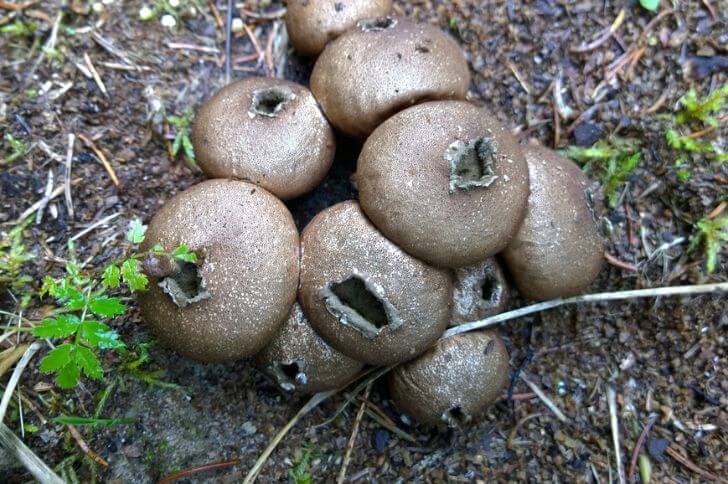
Another type of Vermont mushroom that you may come across is the stump puffball. Also known as Apioperdon pyriforme or pear-shaped puffball, they are gregarious, growing in tight clusters.
Identification:
Young stump puffballs are creamy in color with a pear shaped body and white flesh. As this puffball ages, it discolors and its flesh turns yellow; eventually brown. Stump puffballs typically range from 1-3 inches in diameter.
4. Chicken of the Woods
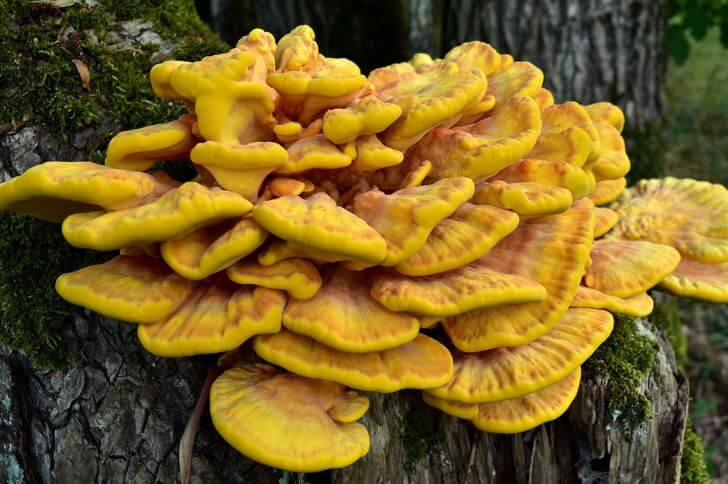
Common in South Vermont, chicken of the woods is one of the top edible mushrooms of Vermont.
Identification:
The bright orange-yellow color sets this mushroom apart from other fungi and its large size makes it one of the most recognizable mushrooms.
It generally grows in overlapping shelves with bright yellow-orange caps that become more brittle and darker with age. It has a soft texture.
The underside features tiny tubes instead of gills like many common mushrooms have which makes them easily identifiable.
Does chicken of the woods grow in Vermont? Yes, you can find sulphur shelf mushrooms from mid-June and they last until the end of summer. Where can you find them? These shelf mushrooms always grow at the base of dying hardwoods.
5. Fly Agaric
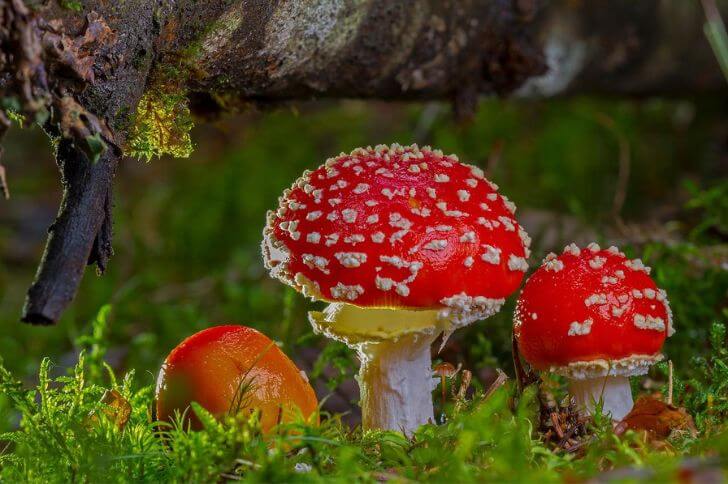
Fly agarics are perhaps the most well-known red fungi in North America. These iconic toadstools are easy to identify.
Identification:
Amanita muscaria caps are red with white warts distributed evenly around the surface. The caps start out convex-shaped becoming slightly concave with maturity.
Underneath, they are white with crowded gills. Spore print is also white as is the stem. Note the volva at their base.
Despite its attractive appearance, the fly agaric mushroom should be avoided.
6. Tremellodendron Pallidum
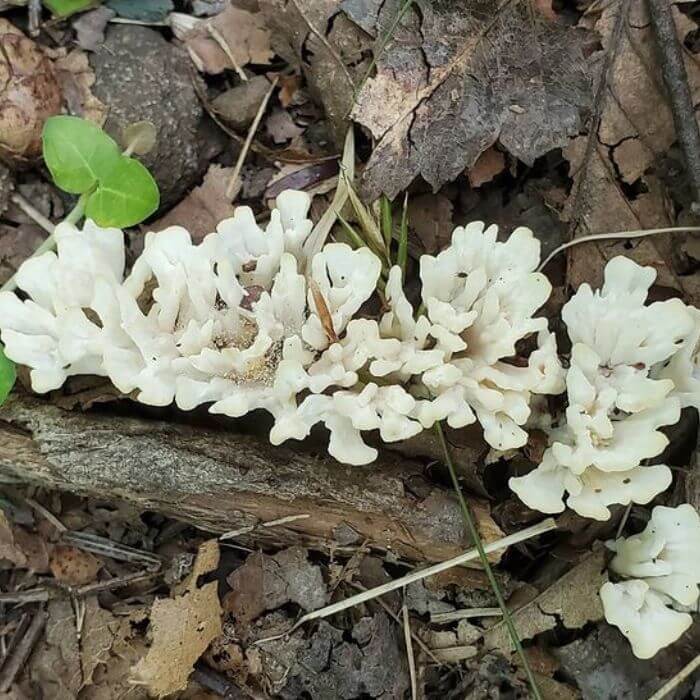
source: shroomwithfufu
After morel season, you may notice tiny “white droppings” on the ground. Within a few they grow to reveal coral mushrooms or tremellodendron pallidum.
Identification:
Also called tremellodendron schweinitzii,the Vermont mushrooms may resemble coral mushrooms but are not related to this fungus species. They are false corals.
It takes forever to grow, meaning it is one of the slowest growing mushrooms. They grow in spring on the forest floor in groups or singly.
Fruiting bodies resemble those of coral mushrooms with branches that are whitish. Texture is tough and they have a white spore print. Its fruiting body grows to 6 inches across. They are pretty common.
7. Clavulinopsis Fusiformis (Golden Spindles)
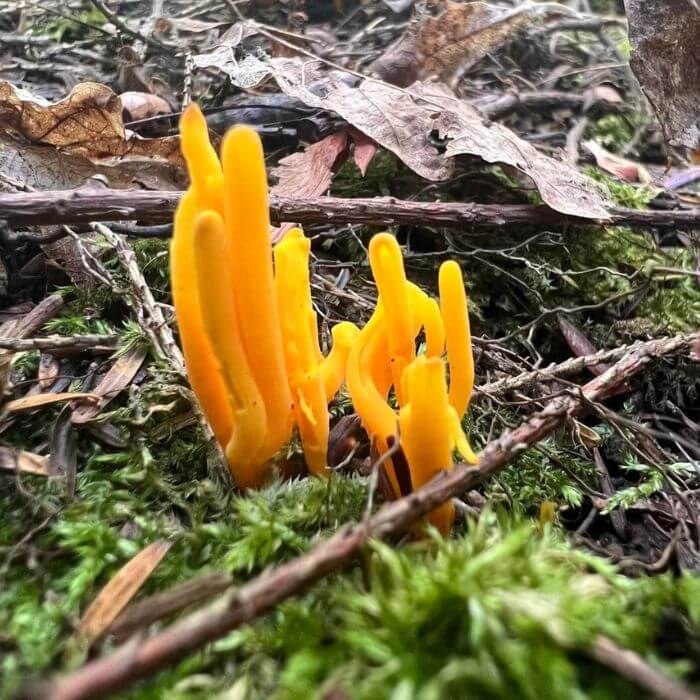
source: mikeacl1313
Clavulinopsis fusiformis, commonly known as the spindle-shaped yellow coral or golden spindle, is another type of coral mushroom found in Vermont.
Identification:
These yellow Vermont mushrooms typically grow in dense clusters. They are a small club-shaped coral mushroom, typically measuring between 2-5.9 inches in length.
Note the pointed tips. Mature species are hollow and are bitter. These mushrooms are not consumed in North America. However, in Nepal they are considered edible.
8. Dryad’s Saddle
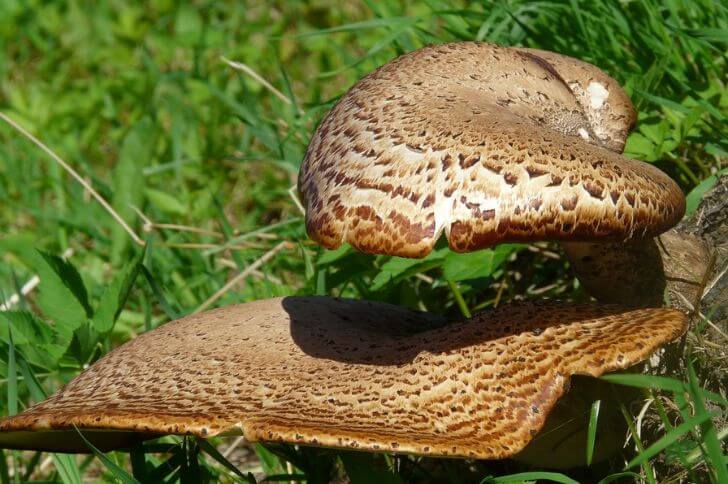
Dryad’s saddle mushroom, also known as Polyporus squamosus, is an edible fungi that grows in moist wooded areas. It is closely related to the common store bought oyster mushrooms.
Identification:
The distinguishing characteristics of Dryad’s saddle include its fan-like shape, with a width of about six inches and a length of up to twelve inches.
Its upper surface is covered with brown scales while its underside consists of several small pores which release spores when mature.
In addition to its unique physical traits, this mushroom also produces a pleasant “watermelon” aroma. Though its taste is not strong, we like it because it does fill a hungry belly fast.
9. Clitocybe Nuda
Clitocybe nuda, colloquially known as Wood Blewit, is an edible species of mushroom in Vermont. It is easily identified by its distinct smell, citrusy, and appearance.
Identification:
The caps are a pale lilac color and smooth. Younger species have incurved margins while older wood blewits have an almost flat cap with wavy margins.
They have gills underneath the cap that are initially lilac but turn brownish in maturity. Its stem is about 3 inches tall with a slightly swollen base.
The smell of wood blewit has been described as fragrant or sweet; it has even been compared to frozen citrus fruits! Additionally, this species has a firm texture when cooked – similar to that of cooked chicken breast.
10. Porcini
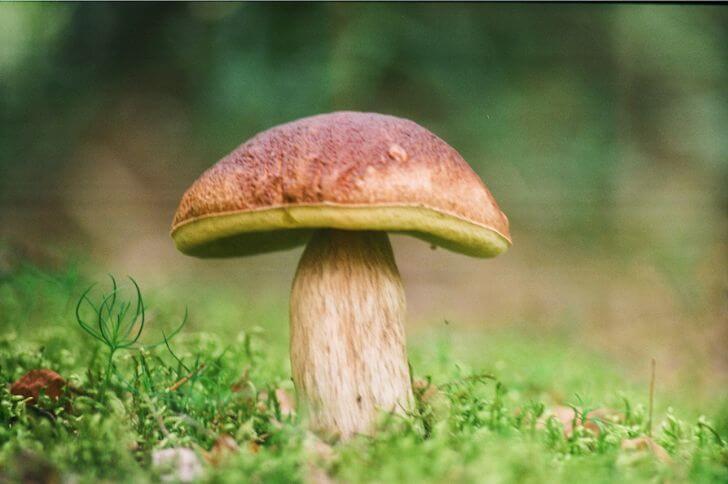
King boletes are one of the largest mushrooms of Vermont. Also known as cep or porcini, they are unmistakable.
Identification:
Porcinis typically grow under coniferous trees like pine and fir. This brown fungus has a distinct appearance that sets it apart from other mushrooms.
It has a large, reddish-brown cap with yellowish pores underneath its surface. The stem can reach 2 to 8 inches tall and up to 3 inches thick.
The flesh of this mushroom is firm and its taste ranges between nutty and meaty with some sweetness at times.
11. Bear’s Head Tooth
Bear’s head tooth fungi are closely related to Lion’s mane. Their striking appearance makes identification easy.
Identification:
To differentiate these white Vermont mushrooms from the lion’s mane, look at their fruiting body. Bear’s head tooth fungi have longer spines and irregular shaped fruiting bodies while lion’s mare have a more round shaped fruiting body and shorter spines.
This white fungus is edible and highly sought after for culinary uses – it can be cooked or used raw in salads or as a garnish.
The mushroom’s flavor ranges from mild to slightly acidic with an undertone of seafood flavor when cooked.
Its texture also varies quite drastically depending on what preparation method it is given before consumption; when sautéed the mushroom takes on an almost crunchy consistency while raw it has more of a soft chewiness akin to fish meat.
12. Shaggy Manes
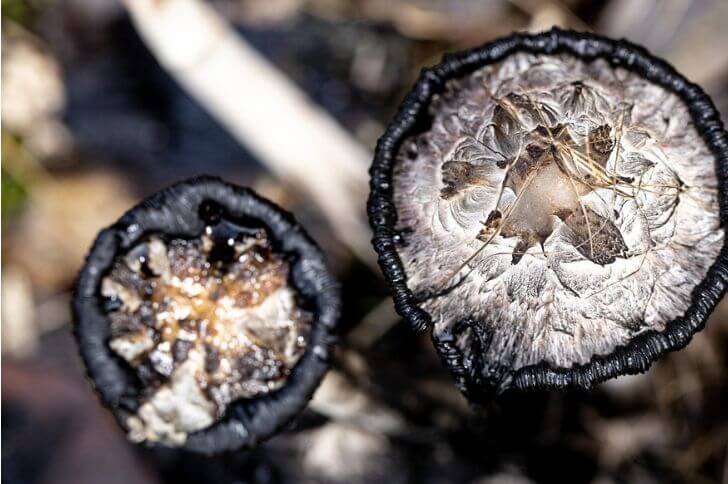
Shaggy manes are everywhere and Vermont is no exception.
Identification:
As their name implies, they are characterized by their unique “shaggy” appearance which consists of long strands that sprout from a rounded cap.
These distinguished-looking mushrooms have a number of aliases including ‘lawyer’s wig’, ‘hairy cap’, and ‘shaggy ink cap’.
The caps of this particular mushroom can range from white in young fungi to black for older species. As they age, they produce an inky like substance from their gills, giving them the ‘inky’ name. They often grow in large numbers in lawns and roadsides.
13. Witch’s Butter
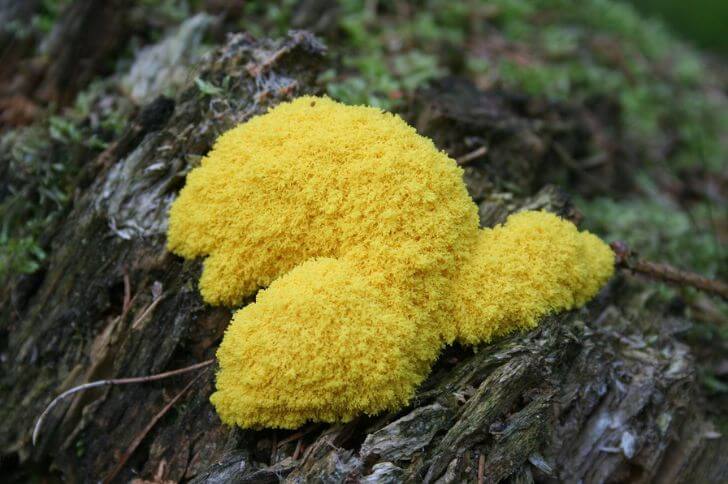
Witch’s Butter Mushroom is a gelatinous, mushroom-like fungus found growing in damp woods or decaying wood. This species is a member of the Tremellaceae family and can also be referred to as Yellow Brain Fungus.
Identification:
It gets its name from the fact that it has a bright yellow color and soft, waxy texture which resembles butter.
It has an uneven surface with folds and wrinkles that give it a brain-like appearance. Witch’s butter is categorized as edible. However they are too small and are ignored by most experienced foragers.
14. Aborted Entoloma
Aborted Entoloma mushroom identification is a task that can be tricky for even the most experienced mushroom hunters. This is because they are rare with weird looking fruiting bodies.
Identification:
These small mushrooms are a baby of entomolas and honeys. Mycologists believe they are a result of entomolas parasitizing honeys.
The caps tend to be contorted “popcorn look”and have brownish fibers on the surface. The gills are dense and close together and turn pinkish in maturity. They taste like honeys.
15. Morels
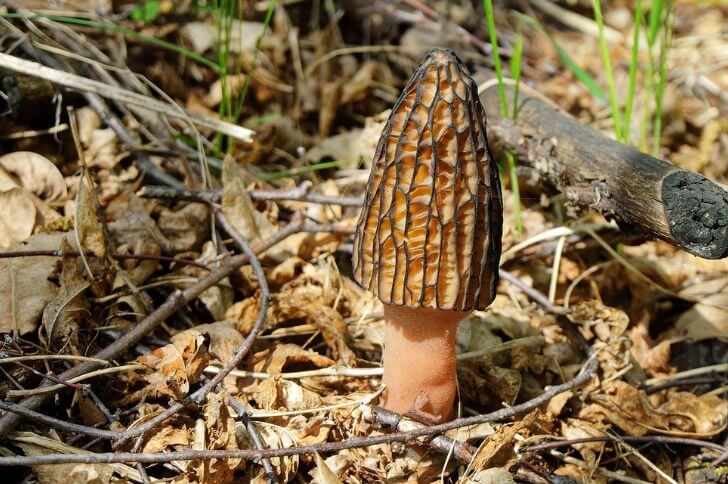
What month is best for morels in Vermont? Starting from late May. They typically grow under maple and ash trees but some are found on wood chips.
Identification:
Vermont morels include:
Black morels: These can be identified by their distinct shape; they are cone-shaped with an irregularly ridged and pitted cap.
Their dark brown or black color sets them apart from other species of morel mushrooms. When cut open, the inside of these unique fungi will appear hollow or honeycombed.
Additionally, black morels have no gills on their underside like other types of mushrooms do.
Yellow morels: The cap of the yellow morel ranges from light tan or golden-yellow in color with a honeycomb pattern of raised ridges that are often connected together. It can range from 1-4 inches in diameter depending on the age of the mushroom.
The stem is white or off-white in color and has an attached ring near the top. When cut open, you’ll notice that both the cap and stem are hollow all the way through with no pockets or cavities on either end.
FAQs
What mushrooms grow in Vermont?
They include:
- Hens of the woods
- Puffballs
- Oysters
- Morels
- Honeys
- Beard’s tooth
- Chanterelles
- Wood blewits
Can you find chaga in Vermont?
Yes, Vermont has a favorable climate for chaga mushrooms. You can spot them on old birch trees. These black mushrooms are used to make teas.
Where can you find mushrooms in Vermont?
- Camels Humps State Forest
- Milton Town Forest
- Mount Ascutney State Park
- Greendale Brook Recreation Area
- Emerald Lake State Park
Where can I find morels in Vermont?
A good place to start your search is in the woods near old apple orchards. Morels often grow near apple trees because they have similar preferences when it comes to soil chemistry and nutrients needed for growth.
They also like areas that have been recently burned by fire or exposed during clear-cutting activities so these places may also be worth exploring as well.
Sources:
Hi There,
My name is Jenny. I’m the Chief Editor at Try Green Recipes and besides making yummy and healthy foods for my kids, grandkids, and friends. I’m new to the blogging world but I believe what I have to share is unique and will bring joy to your home. If you are adventurous and want try something tasty, let’s get started.

